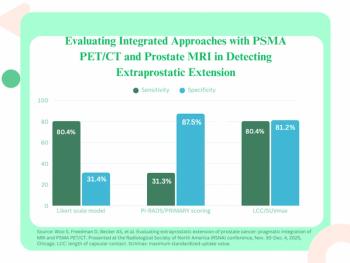
Digital mammography gains market access but analog remains entrenched
The wait for the digital mammography market to take shape may finally be over. Fischer Imaging has joined GE in selling full-field digital units in the U.S., and Hologic, with an
The wait for the digital mammography market to take shape may finally be over. Fischer Imaging has joined GE in selling full-field digital units in the U.S., and Hologic, with an FDA approvable letter in hand, may be only weeks or months away from doing the same. But high prices and continued debate over the relative advantages of different types of detectors could make buyers pause.
Fischer and Hologic use charge-coupled devices (CCD): slot scanning for Fisher and a plate for Hologic. GE¹s system is based on amorphous silicon, while Hologic and other vendors including Sectra, Planmed, and BioScan are planning other technologies. Meanwhile, phosphor-based computed radiography (CR) may be a viable option in the near future. Analog screen-film mammography systems remain the profession¹s workhorses, as vendors continue to upgrade these conventional systems.
BioScan
The Swiss firm, founded in 1990 by physicists from the European Organization for Nuclear Research (CERN), focuses on biomedical x-ray imaging and nondestructive testing. It has developed a prototype digital mammography system using a sensor based on complementary metal-oxide semiconductor (CMOS) technology.
- The work-in-progress Breast Microvision system promises visualization of microcalcifications as small as 20 microns. The system uses thin-film CMOS transistors.
Fischer Imaging
FDA market clearance for SenoScan arrived last fall, placing the vendor second after GE to hit the U.S. market with a full-field digital mammography system. The slot-scanning technology uses CCD detectors. The unit¹s list price is $469,950.
- Soft-copy diagnosis certification was obtained for the digital unit at the same time as the digital scanner itself cleared the FDA. European Community market approval came just before the show. The digital mammography system has a pixel size of about 25 microns and the potential for a 40% to 60% dose reduction compared with screen-film systems.
- The SenoScan AF (advanced film) mammography system was introduced at the show. This screen-film work-in-progress is upgradable to digital technology, ensuring customers who aren¹t ready for the digital investment an easy transition to full-field digital mammography without using a forklift.
Fujifilm Medical Systems
Having once touted its stimulable phosphor CR equipment in mammographic applications and then backed off because of FDA concerns, the Japanese imaging vendor is running clinical trials to prove that its latest technology is up to the task.
- The FCR 5000MA, whose phosphor-based CR technology achieves 50-micron resolution, can read simultaneously from both sides of the imaging plate, boosting detective quantum efficiency (DQE) and reducing noise. A single system could read 30 or more plates daily.
GE Medical Systems
The company was the first vendor to enter the U.S. market with a full-field digital mammography system. Engineers continue to broaden the marketing program for this digital technology, while upgrading conventional systems.
- A new compression paddle and bucky cover were displayed for the analog Senographe DMR+ system, helping boost image quality and patient comfort. The upgrade, dubbed Crystal, offers greater flexibility of the paddle, which leads to more uniform compression on the breast and a better spread of tissue. This can reduce thickness for improved imaging.
- After nearly two years of sales, installations of the full-field digital Senographe 2000D system have reached about 250 globally, with about 150 in the U.S. The digital mammography system is offered at a list price of about $500,000 but sells for less with discounts. Computer-assisted detection for the unit is under development with partner R2 Technology.
- Digital works-in-progress include 3D imaging, contrast mammography, and fusion imaging with ultrasound. 3D mammography offers visualization of different image planes in a volume of data taken with 11 views of the breast. This requires only 1.5 times the dose of asingle-view mammogram.
Hologic
Through its acquisition of Trex Medical, Hologic has ascended to the upper echelon of both screen-film and digital mammography.
- The Lorad full-field digital mammography system was featured. The system, which received an FDA approvable letter in October, is based on a CCD, which may soon be overshadowed by an amorphous selenium technology produced by the firm¹s DirectRay subsidiary.
- The conventional Lorad Affinity mammography system, which also received FDA clearance in October, was showcased. Affinity addresses mid- and low-tier market segments. Shipments are expected to begin the first quarter of 2002.
Instrumentarium Imaging
The company is part of an international vendor of anesthesia and other medical equipment. Instrumentarium Imaging makes several types of commercial mammography products, including Diamond, TACT Digital 3D, Performa, and Alpha.
- Delta DX, a work-in-progress full-field digital system introduced at the 2000 RSNA, was featured again this yearbut with clinical images. The system uses an amorphous selenium detector. The Diamond imaging platform will serve as the basis for Delta DX, although the Performa screen-film product will be upgradable to digital.
- Tuned aperture computed tomography (TACT) technology on the Diamond converts a series of 2D images into 3D volumes independent of the projection angle. This volume can be presented as separate layers of interest or a pseudohologram. Use of 3D imaging may be helpful in diagnosing difficult cases, such as patients with dense tissue.
- The vendor showed improvements to its analog technology, including a new foot pedal design. The Easy Compression System works with the natural mobility of the breast to increase the amount of tissue imaged.
Internazionale Medico Scientifica (IMS)
The company first demonstrated innovative mammographic equipment at the 1993 RSNA meeting. Internazionale Medico Scientifica has continued its development of novel screen-film devices, while launching an effort to produce a full-field digital system.
- Giotto Image, a screen-film system under FDA review, sported a novel circular gantry. The system is designed to improve access to patients.
- Clinical trials in Italy began shortly before the show for the Giotto IMAGE MD, a full-field digital mammography system using Anrad¹s amorphous selenium detector technology.
Philips Medical Systems
Multimodality vendor Philips appears determined to offer something for everyone. The company released a new screen-film system as part of its initiative in women¹s health.
- MammoDiagnost was launched as a highly versatile system for breast imaging and biopsy guidance. The new product, scheduled for introduction in North America in the second half of 2002, can be used to acquire special views and magnified images, as well as to perform stereotactic fine-needle aspiration. It is also useful for needle localization and for specimen radiography
- A motorized swinging gantry arm with two buckys provides enhanced access and easy film changing with the MammoDiagnost. Varying compression ratios are used to adapt compression to the density of the breast.
- Computed radiography might be adapted to the MammoDiagnost, according to the company. The FDA, however, has not yet cleared such a digital application.
Planmed
The Finnish company is best known for its novel Sophie mammography systems, particularly its flagship Planmed Sophie and value-oriented Planmed Sophie Classic.
- The MaxView breast positioning system was launched. The technology, developed by Massachusetts General Hospital, assists technologists in positioning the breast, providing as much as 2 cm more breast tissue for imaging. From 10% to 15% more tissue can be examined on large breasts and as much as 30% on small breasts.
- The vendor is reworking its slot-scanning-based digital mammography product, which was originally shown six years ago using CCD technology. Low detector quantum efficiency and tube heating problems spurred development of a new direct photon counting technology. DQE of the new detector appears substantially higher. Images taken with the new technology may be shown at next year¹s exhibition.
Sectra Imtec
PACS and diagnostic workstations are the focus of Sectra Imtec. The company nonetheless has for several years been developing digital mammography equipment it¹s calling MicroDose Mammography (MDM), which promises to slash radiation dose to one-fifth the amount typically delivered by analog systems.
- Initial patient images generated using the MDM System were shown. Clinical trials were initiated in October at St. Goran¹s hospital in Sweden. European shipments are planned for 2002, and marketing in the U.S. could start in 2003, pending FDA clearance.
- MDM uses a semiconductor-based sensor technology that directly counts x-ray photons, leading to improved detection efficiency and reduced dosage. A proprietary collimator design substantially reduces scatter radiation.
Siemens Medical Systems
Although a major supplier of analog mammographic equipment, as well as a digital biopsy unit, Siemens has not yet developed a digital mammography system. The German vendor is moving in this direction, however, with alliances in CR and flat-panel detectors.
- A partnership with Hologic will be aimed at integrating that company¹s amorphous selenium detector with a mammography platform developed by Siemens.
- A work-in-progress, full-field CR mammography system was displayed. Fuji is contributing to the development of the system, which is pending FDA clearance. The collaboration between Siemens and Fuji was announced at the 2000 RSNA meeting.
- CCD-based Opdima, a small-field digital mammography system optimized for biopsies, was shown as a spot digital device approved for diagnostic work-ups.
- A new flex paddle was displayed for the analog Mammomat systems. The paddle offers better compression on the interior parts of the breast. The SoftSpeed dual-speed compression system improves patient comfort by starting quickly and then slowing down with increasing resistance
Newsletter
Stay at the forefront of radiology with the Diagnostic Imaging newsletter, delivering the latest news, clinical insights, and imaging advancements for today’s radiologists.



























